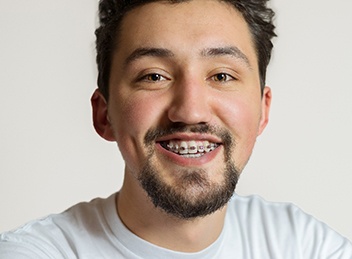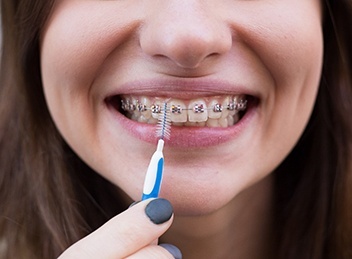Traditional Braces – Bend, OR
The Proven Way to Align Smiles
Whether your general dentist has just referred you for orthodontic treatment, or you feel you could be impacted by misalignment and crowding, investing in traditional braces in Bend can offer you countless benefits, some of which could last a lifetime. Our team at Struble Orthodontics invites you to visit us for a consultation to learn what your treatment options are and what your journey towards a straighter, healthier smile will look like. Call our office today to schedule your appointment.
Why Choose Struble Orthodontics for Traditional Braces?
- Experienced & Compassionate Orthodontists
- We Accept & Maximize Dental Insurance
- Giving Back to Our Community Whenever We Can
How Do Traditional Braces Work?

Traditional braces utilize metal brackets that are attached to each individual tooth and connected by threading an archwire between them all. The wire will be tightened, applying a gentle, yet strategic amount of pressure onto the teeth to encourage them to shift into their ideal alignment. With time, the teeth will move, and if necessary, elastics can also be used to adjust the jaw position and correct bite misalignment. The average traditional braces treatment typically takes between 12 and 24 months, depending on the severity of the orthodontic issues.
What Orthodontic Issues Can Braces Fix?

Trusted by countless patients, traditional metal braces are incredibly versatile and a popular choice among our patients at Struble Orthodontics. They can fix mild, moderate, and more severe orthodontic concerns, allowing patients to address multiple problems at a time.
Bite Misalignment
Bite misalignment, also called malocclusion, is a serious issue that can lead to other conditions if not addressed, like bruxism and TMJ disorder. Whether you suffer from an overbite, underbite, or cross bite, traditional braces can be paired with elastics to guide the jaw into its ideal alignment so you can enjoy a healthier, less-strained bite.
Crowded & Crooked Teeth
Are your teeth crowded, crooked, or overlapping? This isn’t just an aesthetic issue. These orthodontic concerns can increase your risk of oral health problems like cavities by making brushing and flossing more difficult.
Gapped Teeth
Gaps between your teeth can detract from the overall appearance of your smile as well as put your teeth at a greater risk of becoming damaged. Traditional braces can help align your arch, providing your teeth with better protection.
Caring for Your Braces

For the success of your treatment, good dental hygiene and braces maintenance are a must. There’s no need to feel overwhelmed though, because our team will ensure you receive all of the education necessary to prevent cavities and other oral health concerns throughout your treatment. Here are some helpful tips to keep in mind:
- Brush your teeth twice a day with fluoride toothpaste, floss at least once a day, and rinse with an ADA-approved mouthwash daily.
- Avoid foods that are excessively sticky, hard, or chewy.
- Stay hydrated with water and avoid sugary beverages whenever possible.
- Do not chew on objects like pencils, pens, fingernails, or try to open packages with your teeth.
- Visit your dentist every six months for checkups, and stay on top of your routine orthodontic check-ins.
- Use a water flosser or specially designed orthodontic flossers to clean underneath your archwire.
Traditional Braces FAQs
You’re likely already somewhat familiar with the concept of traditional braces, but you will definitely want to learn as much as possible about the treatment before you begin the process of straightening your smile. When you visit our office, we will give you the chance to voice any questions that you might have so that we can answer them. In the meantime, though, you can review the following FAQs to see if they address the inquiries that have been on your mind.
How Long Do Traditional Braces Take?
Some patients only need to wear braces for a single year. In other cases, the treatment may take as long as three years. There are several factors that can affect the timeline:
- Adults typically need to wear braces longer than children since their teeth are more firmly set in place.
- Some orthodontic issues are more severe than others. In general, the distance that the teeth need to move to reach their ideal alignment can have a major influence on how long the treatment takes.
- Your ability to follow any instructions that you’re given (such as wearing rubber bands on braces) could make all the difference for making sure that your treatment stays on schedule.
What Happens After I Get My Braces Off?
Once your braces have been removed, your teeth will start to slowly move back to where they used to be. As such, you will be given a retainer to help you maintain your newly straightened smile. Some retainers are fixed in place, but if a removable retainer is used, you will need to be mindful of wearing it for the required amount of time. Normally, you will need to wear it all day at first, but after a while, you will reach the point where you only need to put it in right before you go to bed.
Can I Get Traditional Braces on Just My Top or Bottom Teeth?
Technically you can, but this generally isn’t the best decision except in very specific circumstances. Wearing braces on one arch but not the other could result in the teeth not coming together the way they should, potentially making existing bite problems worse and leading to TMJ disorder as well as other issues. Therefore, most of the time we will recommend getting braces for both arches of teeth.
What Can I Not Eat with Traditional Braces?
Popcorn, caramel, nuts, hard breads, taco shells, and chips are all examples of foods that are best avoided while wearing braces. The general rule of thumb is to cut hard, chewy, and sticky foods out of your diet for the time being. That said, there are certain foods that you can still enjoy as long as you cut them into small enough pieces first; raw fruits and vegetables as well as pizza crusts are prime examples. Additionally, if you eat corn, make sure that it has been removed from the cob.

